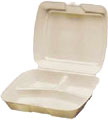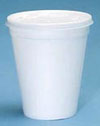Dear Umbra,
I continue to avoid buying Styrofoam, but I don’t really know why. In middle school, I remember being told not to chew on Styrofoam cups because the action of breaking the Styrofoam would deplete the ozone and ingesting it would make me ill. This information, given to me by the lunchroom woman, is all I seem to have on the material. What is it with Styrofoam? Why should we avoid it?
Sincerely,
Sundee
Chicago, Ill.
Dearest Sundee,
I’m sure Lunch Room Woman is a wonderful person, but almost everything she told you was wrong. To begin with, there was no Styrofoam in your lunchroom. Styrofoam is the trademarked name of the Dow Chemical Company’s exclusive blue extruded polystyrene insulation. Making Styrofoam involves putting polystyrene (a petroleum derivative) under tremendous pressure, resulting in very squished particles that are shaped into planks, last forever, and repel water, according to Dow.

This is not a Styrofoam container.
Lunch Room Woman made the very common mistake of conflating Styrofoam with Expanded Polystyrene. Expanded Polystyrene, known as EPS, is made by heating polystyrene particles, pouring them into molds, and injecting them with steam. Meat trays, coffee cups, picnic coolers, and their ilk are all made from EPS, never from Styrofoam. Being particular about saying EPS instead of Styrofoam may be one of those uphill battles, like saying “hook-and-loop fabric adhesive” instead of “Velcro” and “stacked potato wafers” instead of “Pringles.” I have a loved one who tries to avoid using brand names such as “Kleenex” and “Xerox.” It’s a cute habit, but a time-consuming one.
Styrofoam became infamous back in the 1980s for the ozone-depleting CFCs used in its manufacture. Dow replaced CFCs with HCFCs, which are less ozone-depleting — 93.5 percent less, according to the company. (However, they do contribute greenhouse gases to the atmosphere, fueling global warming: Out of the frying pan, into the fire.) Making EPS never involved CFCs or HCFCs, so your meat-tray-chewing habits have never jeopardized the atmosphere. Which leads us to the last correction: It is perfectly safe for you to eat as much EPS as you wish. The nice man at Poison Control assured me that it will neither harm you nor “cause blockage.” However, it has no nutritional value. (Fits right into the cafeteria menu, no?)

The cup runneth over with EPS.
Should you avoid it? There is some debate in the environmental community about whether EPS is an ecologically good or bad product choice. Because it is derived from petroleum, it is not a renewable resource, and it is completely non-biodegradable. Industry advocates consider this a selling point, as EPS will not leach any nasty chemicals into landfill. Solid-waste experts are still unclear as to whether it is better to use products made from paper or EPS; if I uncover any decisive literature in the future, I’ll let you know immediately.
Until then, carry on in a sensible manner, avoiding packaging and disposable containers of all sorts as much as possible.
Crunchily,
Umbra

